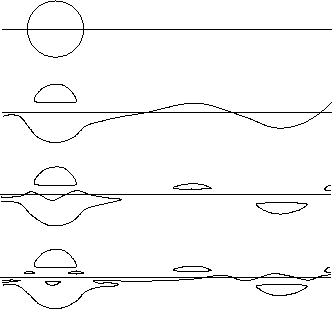 |
In these constructions one obtains different isotopy types of M-curves
depending on the choice of auxiliary curves (more precisely, depending on the
relative location of the intersections
![]() . Recall that
in order to obtain M-curves it is necessary for the intersection
. Recall that
in order to obtain M-curves it is necessary for the intersection
![]() to consist of
to consist of ![]() points and lie in a single
component of the set
points and lie in a single
component of the set
![]() , where for odd
, where for odd ![]() this
component must contain
this
component must contain
![]() . It is easy to see that
the isotopy type of the resulting M-curve of degree
. It is easy to see that
the isotopy type of the resulting M-curve of degree ![]() depends only
on the choice of the components of
depends only
on the choice of the components of
![]() for even
for even
![]() where the intersections
where the intersections
![]() are to be found. If we
take the components containing
are to be found. If we
take the components containing
![]() for even
for even ![]() as
well, then the degree
as
well, then the degree ![]() M-curve obtained from the construction has
isotopy type
M-curve obtained from the construction has
isotopy type
![]() for odd
for odd ![]() and
and
![]() for even
for even ![]() .
In Table 2 we have listed the isotopy types of M-curves of degree
.
In Table 2 we have listed the isotopy types of M-curves of degree
![]() which one obtains from Harnack's construction using all
possible
which one obtains from Harnack's construction using all
possible ![]() .
.
In conclusion, we mention two curious properties of Harnack M-curves, for which the reader can easily furnish a proof.